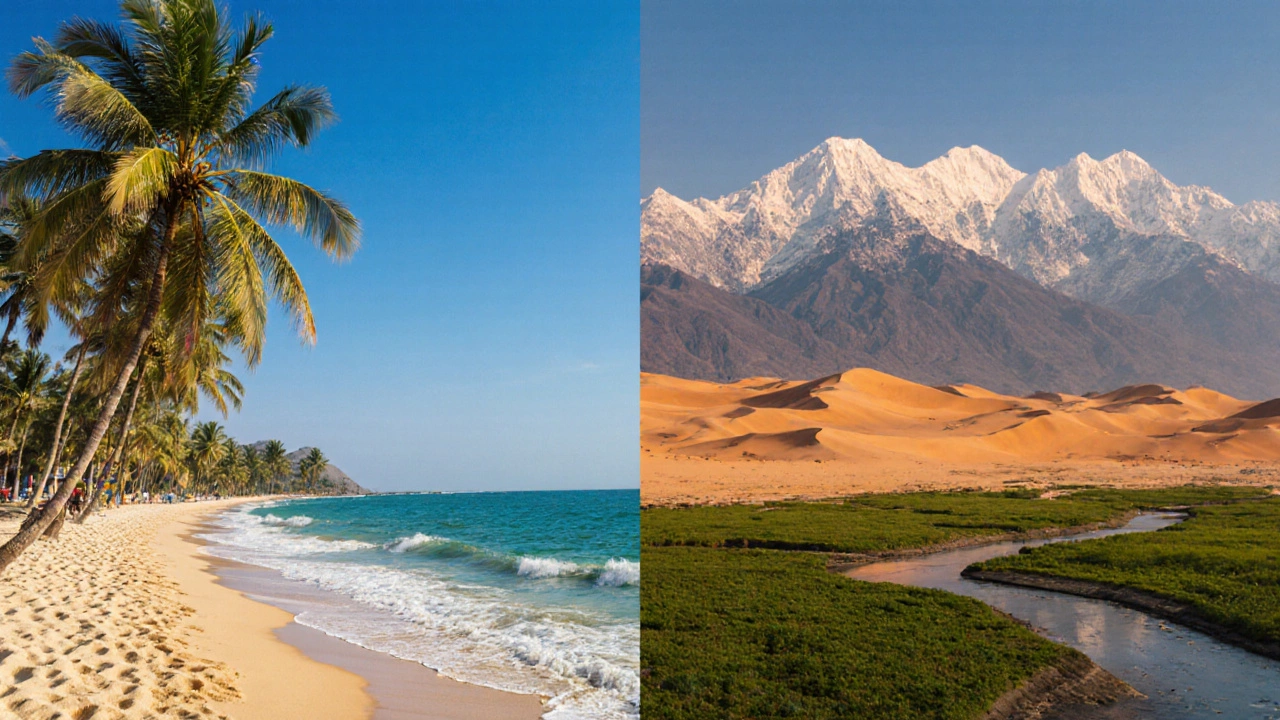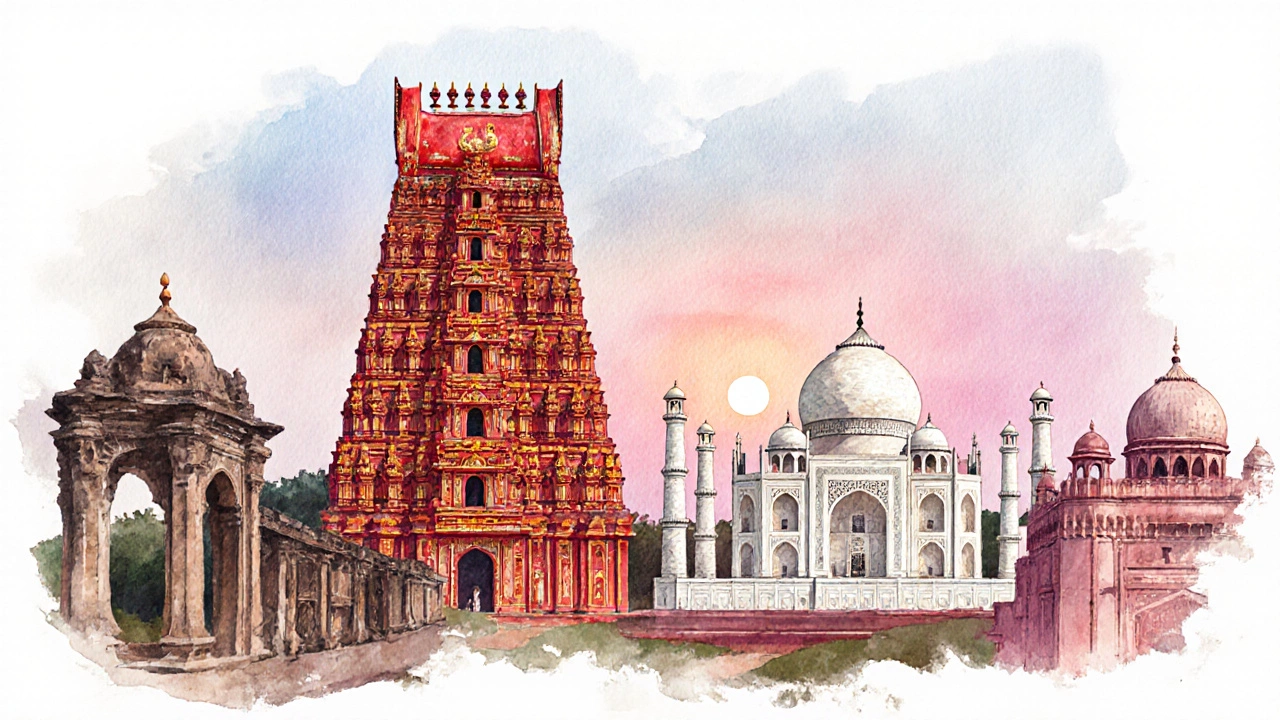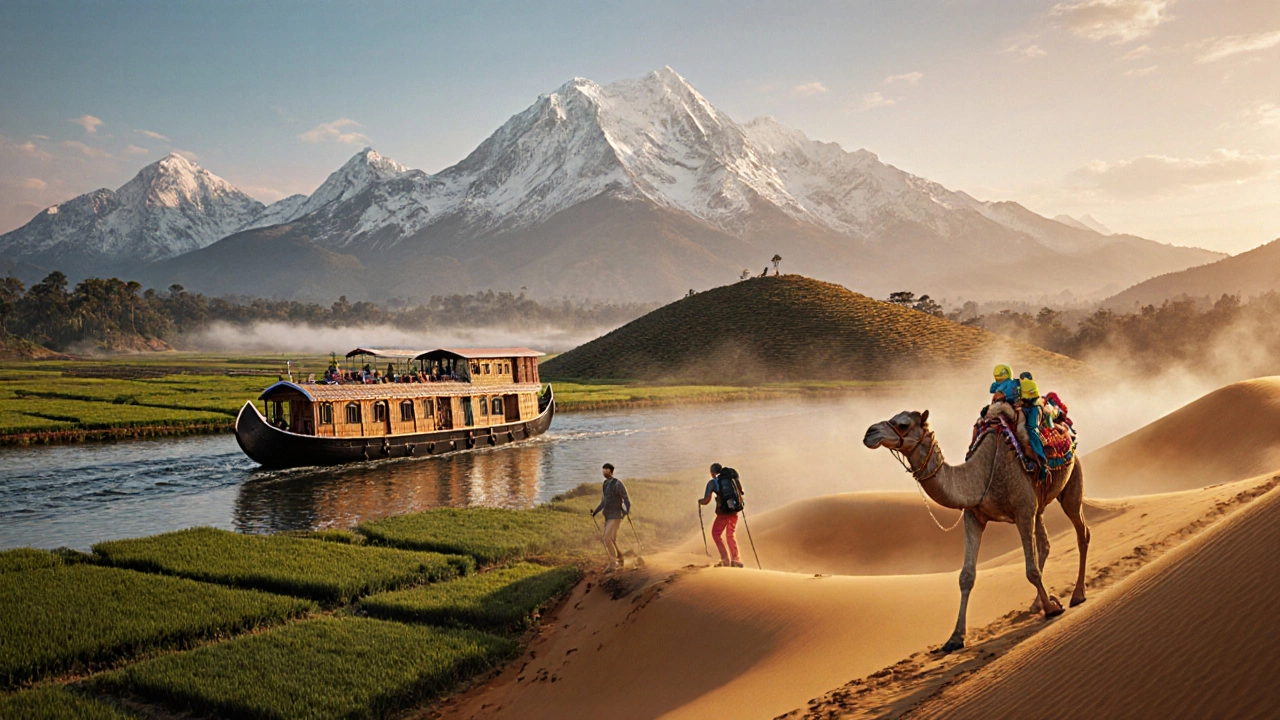South India vs North India: Which Region Is More Beautiful?
 Oct, 25 2025
Oct, 25 2025
India Region Preference Calculator
How Would You Rank These Travel Factors?
Assign weights to each factor based on your preferences. Higher weight = more important to you
When you picture India, you might see snow‑capped peaks or lush, winding backwaters - both are true, but they belong to different halves of the country. South India is a region of peninsular states famous for its tropical coastline, ancient temples, and green hill ranges. It includes Kerala, Tamil Tamil Nadu, Karnataka, Andhra Pradesh, and parts of Goa, offering a mix of spice‑laden cuisine, vibrant festivals, and wildlife sanctuaries. In contrast, North India spans the Himalayas, the fertile plains of the Ganges, and the deserts of Rajasthan, home to iconic monuments like the Taj Mahal and bustling cultural hubs such as Delhi and Amritsar. So, which side of the subcontinent wins the beauty contest? Let’s break it down by landscape, heritage, food, climate and things to do - no fluff, just facts you can use for your next trip.
Landscape: Mountains, Beaches, and Everything in Between
South India’s coastline stretches over 1,500 km, featuring palm‑fringed beaches in Goa, the serene backwaters of Kerala, and the coral reefs of Lakshadweep. The Western Ghats, a UNESCO World Heritage mountain range, runs parallel to the coast and shelters misty hill stations like Munnar and Coorg. North India, on the other hand, boasts the towering Himalayas - think Shimla, Manali, and Leh - plus the arid dunes of the Thar Desert in Rajasthan and the fertile alluvial plains of the Ganges.
| Feature | South India | North India |
|---|---|---|
| Coastline | 1,500 km - Goa, Kerala, Tamil Nadu beaches | Minor - Gujarat and Punjab coasts |
| Mountain Range | Western Ghats (elevations up to 2,695 m) | Himalayas (peaks over 8,000 m) |
| Desert | None | Thar Desert (≈ 200,000 km²) |
| Unique Waterways | Kerala backwaters, Godavari delta | Ganges‑Yamuna floodplains |
Heritage Sites: Temples, Forts, and World‑Wonder Monuments
Both halves claim UNESCO World Heritage sites, but they differ in flavor. South India shines with Dravidian architecture - think the towering gopurams of Meenakshi Temple in Madurai and the intricately carved Hampi ruins. The Mysore Palace combines Hindu, Muslim, and Gothic styles. North India’s crown jewel is the Taj Mahal, a Mughal masterpiece, alongside the forts of Jaipur, Jodhpur and the ancient Buddhist site of Sanchi.
Cuisine: Spice, Flavor, and Regional Diversity
Food lovers often decide based on palate. South Indian dishes revolve around rice, coconut, and tamarind - iconic items include dosa, idli, and the fiery Chettinad chicken. The coastal regions excel at seafood curries and the fermented appam. North Indian cuisine leans on wheat, dairy, and rich gravies - think butter chicken, paneer tikka, and the fragrant biryanis of Lucknow and Hyderabad. Street food thrives everywhere: vada pav in Mumbai (south‑west) versus chaat in Delhi.

Climate and Best Time to Visit
South India enjoys a tropical climate with two monsoons, making the period from October to March ideal for beach holidays and hill‑station trekking. The weather stays warm, rarely dropping below 20 °C. North India’s climate is more extreme: summers can scorch above 40 °C, while winters (December‑February) turn the Himalayas sub‑zero, perfect for snow lovers. The shoulder seasons - October‑November and February‑March - offer clear skies for both desert safaris and temple visits.
Things to Do: From Adventure to Relaxation
- South India: Houseboat cruising in Kerala, trekking the Western Ghats (e.g., Kudremukh), exploring the coffee plantations of Coorg, attending the harvest festival of Onam.
- North India: Camel safaris in Rajasthan’s Thar, Himalayan treks (like the Markha Valley), boat rides on the Dal Lake, visiting the Golden Temple in Amritsar.

Pros and Cons Checklist
- South India
- + Year‑round greenery and coastal breezes.
- + Rich temple art and less crowded heritage sites.
- - Monsoon can disrupt travel in June - September.
- North India
- + Iconic monuments and dramatic landscapes.
- + Seasonal variety - desert, snow, plains.
- - Extreme weather can limit activities (heat in summer, cold in winter).
Bottom Line: Which Is More Beautiful?
Beauty is personal, but if you love lush greenery, tranquil waters, and intricate temple architecture, South India will probably steal your heart. If towering monuments, rugged deserts, and snow‑capped peaks make your eyes light up, North India wins. Most travelers end up falling for both - the subcontinent is huge enough to let you experience the best of both worlds. Plan a two‑week itinerary that starts in Delhi, heads north to the Himalayas, then flies down to Kochi for a backwater cruise. You’ll see why the debate often ends in a happy compromise.
Which season is best for visiting both South and North India?
October to March offers pleasant weather across most of the country - cooler in the north, mild in the south, and the monsoon retreat in the south creates lush scenery.
Do I need a visa to travel between the two regions?
A single Indian visa (tourist, e‑Visa or any other type) covers the entire country, so you can move freely between South and North without extra paperwork.
What are the top three must‑see places in South India?
Kerala backwaters (Alleppey), the Meenakshi Temple in Madurai, and the hill station of Coorg (Kodagu) are often ranked as the most iconic experiences.
What are the top three must‑see places in North India?
The Taj Mahal in Agra, the Jaipur forts (Amber, Nahargarh), and the Himalayan town of Leh are the standout highlights.
Is it safe for solo travelers in both regions?
Yes, both South and North India have well‑established tourist infrastructures. Stick to popular routes, use reputable transport, and follow usual travel safety tips.
How does budget differ between South and North India?
Both regions are budget‑friendly, but accommodations in peak South Indian beach towns can be slightly pricier than hostels in Delhi or Jaipur. Overall, a daily budget of $30‑$50 covers meals, transport, and modest lodging across the board.